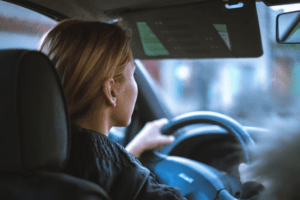You’ll sometimes find standard auto insurance providers that offer high-risk auto insurance, but many do not. Insurance companies gear SR22 and FR44 policies toward people who are high-risk drivers.
Who Are High-Risk Drivers?
Generally, insurance carriers consider people with checkered driving records to be high-risk drivers. If your DMV record shows you’ve accumulated multiple tickets or been responsible for several accidents, insurance carriers may classify you as a high-risk driver. Likewise, insurance companies also consider drivers with criminal charges, DUIs, and other similar actions to be high-risk drivers.
High-risk drivers generally have to pay higher insurance premiums because most insurance companies don’t feel comfortable insuring them. Typically, a single accident or a few tickets won’t increase a driver’s risk to insurance companies. However, insurance companies will consider them high risk if they also undertake illegal actions.
High-risk driving behaviors share the following similarities:
- Driving without a seat belt
- Texting or using the Internet while driving
- Speeding at least ten miles or more over the speed limit
- Drinking and driving
Younger men are likelier to be high-risk drivers than other demographics. Incidents like these result in suspension of the driver’s license, requiring SR-22 or FR-44 insurance for reinstatement.
How Much Do Insurance Premiums Rise for High-Risk Drivers?
It’s no secret that high-risk drivers have higher insurance premiums. It’s challenging to say how much insurance premiums rise for high-risk drivers because various factors can affect the premium price. In addition, insurance premiums also vary depending on your driving history, state, and insurance provider. However, some research gives you a baseline idea about insurance premiums for high-risk drivers.
Car Insurance Premiums After A DUI
Drunk driving is a primary cause of traffic fatalities. The National Highway Traffic Safety Administration (NHTSA) estimates that 28 people die in drunk-driving crashes daily in the US. Insurance companies generally consider DUI the riskiest driving behavior. The national average for a full-coverage insurance premium is approximately $1,674. However, drivers with DUIs usually pay $3,139 for the same insurance. Florida requires drivers to obtain an FR-44 certificate to reinstate their license if they commit a DUI violation.
Premiums After At-Fault Accidents
Research shows that being responsible for a car accident can raise your premium because insurance agencies consider it a red flag. Drivers accountable for an accident must pay $2,311 on average. That’s approximately 38 percent more than the national average full-coverage premium.
Premiums After Speeding Tickets
Insurance agencies are also wary of drivers with speeding tickets. According to NHTSA, speeding causes approximately one-third of all car crash fatalities. As a result, drivers with multiple speeding tickets can expect their insurance premiums to rise by 20 to 30 percent.
New Drivers and Coverage Lapses
 Some states consider teens and young adult drivers a higher insurance risk than others. That’s because these drivers have less driving experience on roadways than adults with years of driving experience. According to the CDC, seven teens die daily in car crashes. As a result, most teens will have to pay higher insurance premiums.
Some states consider teens and young adult drivers a higher insurance risk than others. That’s because these drivers have less driving experience on roadways than adults with years of driving experience. According to the CDC, seven teens die daily in car crashes. As a result, most teens will have to pay higher insurance premiums.
Likewise, driving with a lapsed insurance will also make you a higher insurance risk. Your premiums will likely spike in this scenario.
Get High-Risk Insurance from UltraCar Insurance
Are you looking for a full-coverage auto insurance policy in Florida? UltraCar Insurance has you covered. We’re a leading SR-22 and FR-44 insurance provider in Florida. In addition, we also provide non-owner FR-44 insurance and non-owner SR-22 insurance. Visit our website to learn more. Alternatively, start an online quote today!

